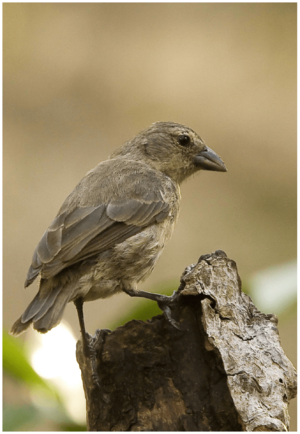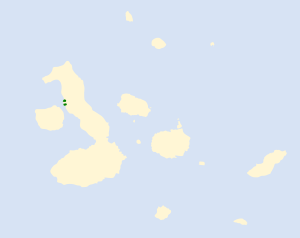Mangrove finch facts for kids
Quick facts for kids Mangrove finch |
|
|---|---|
 |
|
| Conservation status | |
| Scientific classification | |
| Genus: |
Camarhynchus
|
| Species: |
heliobates
|
 |
|
| Synonyms | |
|
Geospiza heliobates |
|
The mangrove finch (Camarhynchus heliobates) is a special type of bird. It belongs to a group called Darwin's finches. These birds are part of the tanager family. The mangrove finch lives only in the Galápagos Islands. This means it is endemic to these islands.
Scientists used to find these finches on Fernandina and Isabela islands. However, recent searches have not found them on Fernandina. Today, they live in just two large mangrove areas on Isabela Island.
This finch is very rare. Experts believe there were only about 20 to 40 adult birds left in 2021. Because there are so few, they are in danger of disappearing forever.
Where Mangrove Finches Live
As its name suggests, the mangrove finch makes its home in mangrove forests. These special forests grow along the coastlines of the Galápagos Islands.
The finch finds all its food in these mangroves. It eats different kinds of insects and their larvae. It also enjoys spiders and some plant parts. The mangrove finch looks a lot like the woodpecker finch. However, unlike the woodpecker finch, it is not known to use tools to find food.
Who Hunts Mangrove Finches
Mangrove finches face many dangers from other animals. Their main hunters are cats, fire ants, and paper wasps. But the most harmful are black rats and tiny parasitic flies.
Black rats (Rattus rattus) are a big problem. They cause about 54% of finch eggs to die during the time they are incubating. This means more than half of the eggs are lost to rats.
Another threat comes from the larvae of the avian vampire fly (Philornis downsi). These tiny fly larvae kill about 14% of newly hatched finch chicks.
To help the finches, people spread rat poison in some mangrove areas in 2007 and 2008. This helped a lot! Rat attacks on finch eggs dropped to 30%. Before the poison, rats attacked 70% of nests. Only 18% of nests were successful.
By 2013, the avian vampire fly had spread even more. This fly arrived in the Galapagos Islands around the 1960s. It has killed about 55% of all Darwin's finch babies in their nests.
Helping the Mangrove Finch
The mangrove finch is listed as critically endangered on the IUCN Red List. This means it is very close to disappearing forever. In 2021, there were only an estimated 20 to 40 adult birds left.
Good news came in January 2014. Project researchers successfully raised 15 mangrove finch chicks in a safe place. After they grew, these young birds were released back into the wild. This project is called "head-starting." Since then, 36 young finches have been head-started. The project continues to grow and help more birds.
The Mangrove Finch Project is a team effort. It involves the Charles Darwin Foundation and Galapagos National Park. They work with San Diego Zoo Global and Durrell Wildlife Conservation Trust. Many other groups also support this important work. These include the Galapagos Conservation Trust and the Mohamed bin Zayed Species Conservation Fund.
See also
 In Spanish: Pinzón de Darwin manglero para niños
In Spanish: Pinzón de Darwin manglero para niños


